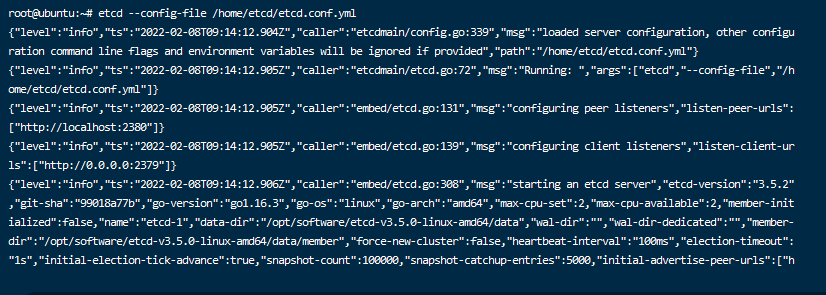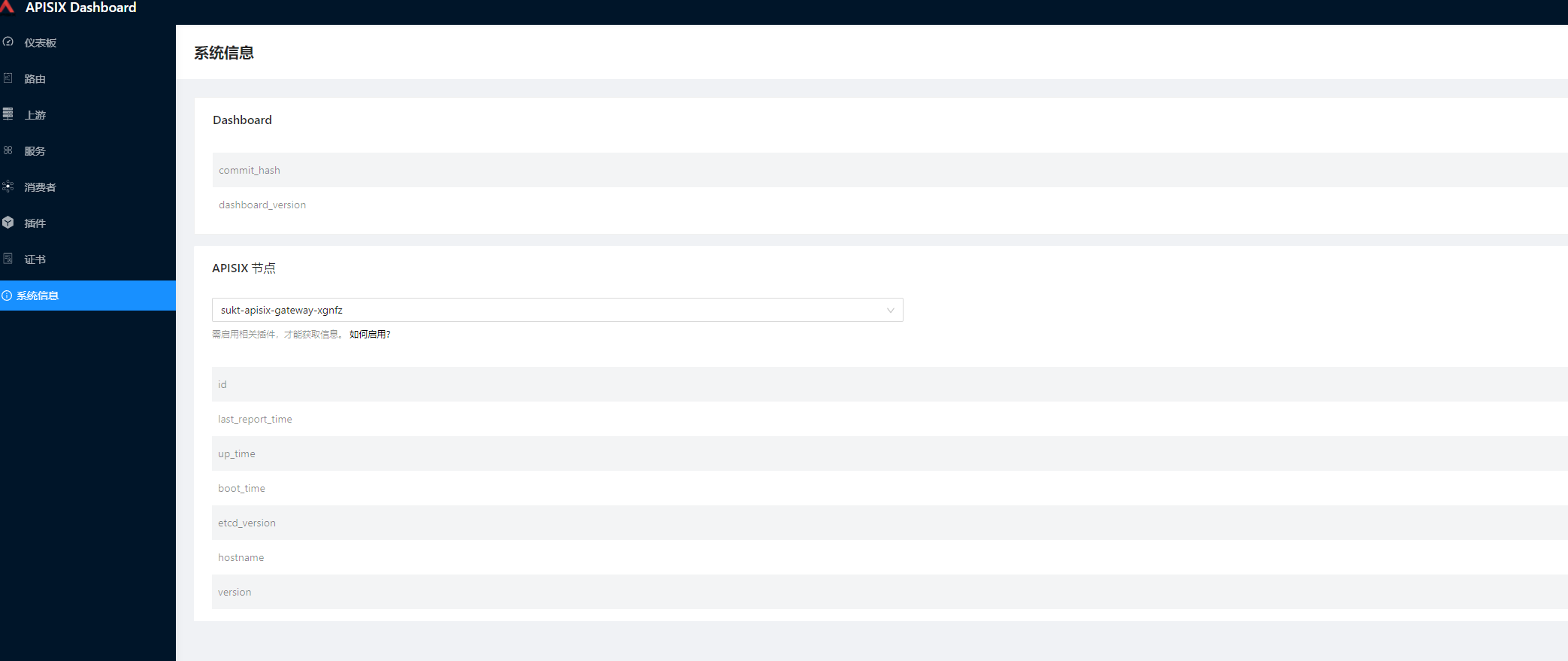不使用pvc的方式在K8S中部署apisix-gateway
不使用pvc的方式在K8S中部署apisix-gateway
简介
我的apisix使用etcd作为数据存储服务器,官方的使用pvc方式或者docker-compose的方式,对于新手不太友好,本篇是从etcd的安装到apisix的打通都会涉及。
部署etcd
etcd 是一个分布式键值对存储,设计用来可靠而快速的保存关键数据并提供访问。通过分布式锁,leader选举和写屏障(write barriers)来实现可靠的分布式协作。etcd集群是为高可用,持久性数据存储和检索而准备。
ubuntu部署etcd
ubuntu中部署etcd的两种方式:
一种是去GitHub下载二进制的安装包,还有一种是apt-get install etcd,第二种方式我也尝试过,可能是我软件源的问题,版本有点老,所以我就换成了使用第一种方式,而且也比较推荐使用第一种方式。
我用的etcd下载的版本是3.5.2,废话不多说直接看步骤:
1、将etcd etcdctl etcdutl 二进制文件拷贝到/usr/local/bin目录下
/usr/local/bin
2、创建一个etcd的etcd.conf.yml,将下面代码拷贝进去,我这里etcd就简单的配置了一下,没有做集群,所以yml很简单。
name: etcd-1
data-dir: /home/etcd/data
listen-client-urls: http://0.0.0.0:2379
advertise-client-urls: http://0.0.0.0:2379
3、通过etcd --config-file etcd.conf.yml的路径运行,如下图就是成功了,也可以使用etcd manager客户端来测试。


4、如果使用etcd直接启动的话没有办法后台运行,所以我们需要在/etc/systemd/system目录下创建一个etcd.service来进行后台运行。
[Unit]
Description=ETCD Server
Documentation=https://github.com/coreos/etcd
After=network-online.target
Wants=network-online.target [Service]
User=root
Group=root
ExecStart= etcd --config-file /home/etcd/etcd.conf.yml [Install]
WantedBy=multi-user.target
5、创建好之后可以通过以下命令来确定运行状态如下图:
# 启动
sudo systemctl start etcd.service
# 查看状态
sudo systemctl status etcd.service
# 开机自启
sudo systemctl enable etcd.service

6、设置用户名和密码# 设置版本为V3
export ETCDCTL_API=3
# 添加用户
etcdctl user add root
# 开启认证
etcdctl auth enable
K8S部署apisix
apisix-gateway在部署的时候分为两块,分别是apisix和apisix-dashboard面板,所以看起来比较绕,不过apisix在部署的时候使用的是yaml文件覆盖的方式,所以我这里是将yaml存储到configmap中了,方便进行统一管理。我使用的k8s是Ubuntu出品的microk8s,用它的主要原因是因为配置简单。
- apisix是服务端,用来进行网络请求转发。
- apisix-dashboard是他的控制面板,用来进行可视化配置。
apisix介绍
apisix是基于 OpenResty + etcd 实现的云原生、高性能、可扩展的微服务 API 网关。它是国人开源,目前已经进入 Apache 进行孵化。APISIX 通过插件机制,提供了动态负载平衡、身份验证、限流限速等等功能,当然我们也可以自己开发插件进行拓展。
- 动态负载均衡:跨多个上游服务的动态负载均衡,目前已支持 round-robin 轮询和一致性哈希算法。
- 身份验证:支持 key-auth、JWT、basic-auth、wolf-rbac 等多种认证方式。
- 限流限速:可以基于速率、请求数、并发等维度限制。
部署apisix
1、创建apisix.conf.yaml,并存储到configmap中,
apisix:
node_listen: 9080 # APISIX listening port
enable_ipv6: false allow_admin: # http://nginx.org/en/docs/http/ngx_http_access_module.html#allow
- 0.0.0.0/0 # We need to restrict ip access rules for security. 0.0.0.0/0 is for test. admin_key:
- name: "admin"
key: edd1c9f034335f136f87ad84b625c8f1
role: admin # admin: manage all configuration data
# viewer: only can view configuration data
- name: "viewer"
key: 4054f7cf07e344346cd3f287985e76a2
role: viewer enable_control: true
control:
ip: "0.0.0.0"
port: 9092 etcd:
host: # supports defining multiple etcd host addresses for an etcd cluster
- "http://192.168.31.170:2379"
user: "root" # ignore etcd username if not enable etcd auth
password: "root" # ignore etcd password if not enable etcd auth discovery:
nacos:
host:
- "http://47.100.213.49:8848"
prefix: "/nacos/v1/"
fetch_interval: 30 # default 30 sec
weight: 100 # default 100
timeout:
connect: 2000 # default 2000 ms
send: 2000 # default 2000 ms
read: 5000 # default 5000 ms plugin_attr:
prometheus:
export_addr:
ip: "0.0.0.0"
port: 9091 plugins:
- client-control
- ext-plugin-pre-req
- zipkin
- request-id
- fault-injection
- serverless-pre-function
- batch-requests
- cors
- ip-restriction
- ua-restriction
- referer-restriction
- uri-blocker
- request-validation
- openid-connect
- wolf-rbac
- hmac-auth
- basic-auth
- jwt-auth
- key-auth
- consumer-restriction
- authz-keycloak
- proxy-mirror
- proxy-cache
- proxy-rewrite
- api-breaker
- limit-conn
- limit-count
- limit-req
- gzip
- server-info
- traffic-split
- redirect
- response-rewrite
- grpc-transcode
- prometheus
- echo
- http-logger
- sls-logger
- tcp-logger
- kafka-logger
- syslog
- udp-logger
- serverless-post-function
- ext-plugin-post-req stream_plugins:
- ip-restriction
- limit-conn
- mqtt-proxy
2、使用kubectl命令创建configmap
kubectl create configmap sukt-apisix-gateway-config --from-file=config.yaml=/home/sukt-platform/apisix/apisix-gateway-config.yaml -n sukt-platform
3、新建apisix-deployment.yaml
apiVersion: apps/v1
kind: Deployment
metadata:
name: sukt-apisix-gateway
namespace: sukt-platform
spec:
selector:
matchLabels:
app: sukt-apisix-gateway
template:
metadata:
labels:
app: sukt-apisix-gateway
spec:
containers:
- name: sukt-apisix-gateway
image: apache/apisix:2.10.3-alpine
imagePullPolicy: IfNotPresent
resources:
limits:
cpu: 500m
memory: 1Gi
requests:
cpu: 250m
memory: 256Mi
securityContext:
privileged: false
terminationMessagePath: /dev/termination-log
terminationMessagePolicy: File
volumeMounts:
- mountPath: /usr/local/apisix/conf/config.yaml
name: config
subPath: config.yaml
ports:
- containerPort: 9080
- containerPort: 9443
dnsPolicy: ClusterFirst
restartPolicy: Always
schedulerName: default-scheduler
securityContext: {}
terminationGracePeriodSeconds: 30
volumes:
- configMap:
defaultMode: 420
name: sukt-apisix-gateway-config
name: config4、新建apisix-service.yaml
apiVersion: v1
kind: Service
metadata:
name: sukt-apisix-gateway-nodetype
labels:
app: sukt-apisix-gateway-nodetype
namespace: sukt-platform
spec:
type: NodePort
selector:
app: sukt-apisix-gateway
ports:
- port: 9080
name: transfer1
targetPort: 9080
nodePort: 30107
- port: 9443
name: transfer2
targetPort: 9443
nodePort: 30108部署apisix-dashboard
1、创建apisix-dashboard-config.yaml,并存储到configmap中,
#
# Licensed to the Apache Software Foundation (ASF) under one or more
# contributor license agreements. See the NOTICE file distributed with
# this work for additional information regarding copyright ownership.
# The ASF licenses this file to You under the Apache License, Version 2.0
# (the "License"); you may not use this file except in compliance with
# the License. You may obtain a copy of the License at
#
# http://www.apache.org/licenses/LICENSE-2.0
#
# Unless required by applicable law or agreed to in writing, software
# distributed under the License is distributed on an "AS IS" BASIS,
# WITHOUT WARRANTIES OR CONDITIONS OF ANY KIND, either express or implied.
# See the License for the specific language governing permissions and
# limitations under the License.
# conf:
listen:
host: 0.0.0.0 # `manager api` listening ip or host name
port: 9000 # `manager api` listening port
allow_list: # If we don't set any IP list, then any IP access is allowed by default.
- 0.0.0.0/0
etcd:
endpoints: # supports defining multiple etcd host addresses for an etcd cluster
- "http://192.168.31.170:2379"
# yamllint disable rule:comments-indentation
# etcd basic auth info
username: "root" # ignore etcd username if not enable etcd auth
password: "root" # ignore etcd password if not enable etcd auth
mtls:
key_file: "" # Path of your self-signed client side key
cert_file: "" # Path of your self-signed client side cert
ca_file: "" # Path of your self-signed ca cert, the CA is used to sign callers' certificates
# prefix: /apisix # apisix config's prefix in etcd, /apisix by default
log:
error_log:
level: warn # supports levels, lower to higher: debug, info, warn, error, panic, fatal
file_path:
logs/error.log # supports relative path, absolute path, standard output
# such as: logs/error.log, /tmp/logs/error.log, /dev/stdout, /dev/stderr
access_log:
file_path:
logs/access.log # supports relative path, absolute path, standard output
# such as: logs/access.log, /tmp/logs/access.log, /dev/stdout, /dev/stderr
# log example: 2020-12-09T16:38:09.039+0800 INFO filter/logging.go:46 /apisix/admin/routes/r1 {"status": 401, "host": "127.0.0.1:9000", "query": "asdfsafd=adf&a=a", "requestId": "3d50ecb8-758c-46d1-af5b-cd9d1c820156", "latency": 0, "remoteIP": "127.0.0.1", "method": "PUT", "errs": []}
authentication:
secret:
secret # secret for jwt token generation.
# NOTE: Highly recommended to modify this value to protect `manager api`.
# if it's default value, when `manager api` start, it will generate a random string to replace it.
expire_time: 3600 # jwt token expire time, in second
users: # yamllint enable rule:comments-indentation
- username: admin # username and password for login `manager api`
password: P@ssW0rd
- username: user
password: P@ssW0rd plugins: # plugin list (sorted in alphabetical order)
- api-breaker
- authz-keycloak
- basic-auth
- batch-requests
- consumer-restriction
- cors
# - dubbo-proxy
- echo
# - error-log-logger
# - example-plugin
- fault-injection
- grpc-transcode
- hmac-auth
- http-logger
- ip-restriction
- jwt-auth
- kafka-logger
- key-auth
- limit-conn
- limit-count
- limit-req
# - log-rotate
# - node-status
- openid-connect
- prometheus
- proxy-cache
- proxy-mirror
- proxy-rewrite
- redirect
- referer-restriction
- request-id
- request-validation
- response-rewrite
- serverless-post-function
- serverless-pre-function
# - skywalking
- sls-logger
- syslog
- tcp-logger
- udp-logger
- uri-blocker
- wolf-rbac
- zipkin
- server-info
- traffic-split
2、使用kubectl命令创建configmap
kubectl create configmap sukt-apisix-dashboard-config --from-file=config.yaml=/home/sukt-platform/apisix/apisix-dashboard-config.yaml -n sukt-platform
3、新建apisix-dashboard-deployment.yaml
apiVersion: apps/v1
kind: Deployment
metadata:
name: sukt-apisix-dashboard
namespace: sukt-platform
spec:
selector:
matchLabels:
app: sukt-apisix-dashboard
template:
metadata:
labels:
app: sukt-apisix-dashboard
spec:
nodeName: microk8sslave1 # 部署到指定的node节点
containers:
- name: sukt-apisix-dashboard
image: apache/apisix-dashboard:2.10.1-alpine
imagePullPolicy: IfNotPresent
resources:
limits:
cpu: 500m
memory: 1Gi
requests:
cpu: 250m
memory: 256Mi
securityContext:
privileged: false
terminationMessagePath: /dev/termination-log
terminationMessagePolicy: File
volumeMounts:
- mountPath: /usr/local/apisix-dashboard/conf/conf.yaml
name: config
subPath: config.yaml #这个位置对应的是comfigmap中的名字,不是 /usr/local/apisix-dashboard/conf/conf.yaml
ports:
- containerPort: 9000
dnsPolicy: ClusterFirst
restartPolicy: Always
schedulerName: default-scheduler
securityContext: {}
terminationGracePeriodSeconds: 30
volumes:
- configMap:
defaultMode: 420
name: sukt-apisix-dashboard-config
name: config4、新建apisix-dashboard-service.yaml
apiVersion: v1
kind: Service
metadata:
name: sukt-apisix-dashboard-nodetype
labels:
app: sukt-apisix-dashboard-nodetype
namespace: sukt-platform
spec:
type: NodePort
selector:
app: sukt-apisix-dashboard
ports:
- port: 9000
name: transfer1
targetPort: 9000
nodePort: 30109
运行效果图
可以通过dashboard面板的系统信息查看apisix-gateway的运行信息


结语
apisix-gateway文章分为两篇,本篇只是讲解了如何在k8s中安装以及启动,下一章讲解如何进行转发以及其他功能测试等。
不使用pvc的方式在K8S中部署apisix-gateway的更多相关文章
- K8S中部署apisix(非ingress)
不使用pvc的方式在K8S中部署apisix-gateway 简介 因为公司项目准备重构,现在做技术储备,之前公司项目使用的ocelot做网关,ocelot是.net平台下的一个网关,也是很不错,但是 ...
- k8s中部署springcloud
安装和配置数据存储仓库MySQL 1.MySQL简介 2.MySQL特点 3.安装和配置MySQL 4.在MySQL数据库导入数据 5.对MySQL数据库进行授权 1.MySQL简介 MySQL 是一 ...
- 在k8s中部署前后端分离项目进行访问的两种配置方式
第一种方式 (1) nginx配置中只写前端项目的/根路径配置 前端项目使用的Dockerfile文件内容 把前端项目编译后生成的dist文件夹放在nginx的html默认目录下,浏览器访问前端项目时 ...
- Prometheus K8S中部署Alertmanager
Prometheus K8S中部署Alertmanager 设置告警和通知的主要步骤如下:一.部署Alertmanager二.配置Prometheus与Alertmanager通信三.配置告警 1. ...
- Kubernetes之在k8s中部署Java应用
部署好了k8s以后 部署参考https://www.cnblogs.com/minseo/p/12055731.html 怎么在k8s部署应用 项目迁移到k8s平台是怎样的流程 1,制作镜像 2,控制 ...
- Docker & k8s 系列三:在k8s中部署单个服务实例
本章将会讲解: pod的概念,以及如何向k8s中部署一个单体应用实例. 在上面的篇幅中,我们了解了docker,并制作.运行了docker镜像,然后将镜像发布至中央仓库了.然后又搭建了本机的k8s环境 ...
- 【转】K8S中部署Helm
K8S中的包管理工具 1. 客户端Helm(即Helm) 通过脚本安装:curl https://raw.githubusercontent.com/helm/helm/master/scripts ...
- k8s集群中部署prometheus server
1.概述 本文档主要介绍如何在k8s集群中部署prometheus server用来作为监控的数据采集服务器,这样做可以很方便的对k8s集群中的指标.pod的.节点的指标进行采集和监控. 2.下载镜像 ...
- 使用 Nocalhost 开发 Kubernetes 中的 APISIX Ingress Controller
本文作者:黄鑫鑫 - Nocalhost 项目核心开发者 腾讯云 CODING DevOps 研发工程师.硕士毕业于中山大学数据科学与计算机学院,曾负责过平安云主机及国家超算中心容器云平台等相关业务, ...
随机推荐
- Nginx 常用配置清单
侦听端口: server {# Standard HTTP Protocollisten 80;# Standard HTTPS Protocollisten 443 ssl;# For http2l ...
- Normalized Cuts and Image Segmentation
目录 概 主要内容 求解 相似度 总的算法流程 skimage.future.graph.cut Shi J. and Malik J. Normalized cuts and image segme ...
- 【Azure 应用服务】探索在Azure上设置禁止任何人访问App Service的默认域名(Default URL)
问题描述 总所周知,Azure App Service服务会默认提供一个 ***.chinacloudsites.cn为后缀的域名,但是该域名由上海蓝云网络科技有限公司备案,仅用于向其客户提供 Azu ...
- MySQL数据操作与查询笔记 • 【第3章 DDL 和 DML】
全部章节 >>>> 本章目录 3.1 使用 DDL 定义数据库表结构 3.1.1 SQL 简介 3.1.2 维护数据库和创建数据表 3.2 使用 DDL 维护数据库表结构 ...
- JSON生成Java实体类
https://www.bejson.com/json2javapojo/new/ 至于效果怎么样,自己试一下就知道了
- html基础 下拉菜单和文本域的基本操作
结构代码 所在城市: <select > <option selected>北京</option> <option>上海</option> ...
- Microsoft HoloLens 开发(2): 运行Hello World
1.下载 MixedRealityToolkit-Unity (混合现实工具包) 什么是 MixedRealityToolkit-Unity ? 一个脚本和组件的集合,加速针对微软全息和Windows ...
- Python中单下划线与双下划线用法总结
看mentor的脚本时,遇到self._item.callspec.getparam('')语句,理解起来比较困难,找到一篇文章,记录的比较详细,特别记录一下,以备复习. 附链接地址:http://w ...
- Spring Boot Admin,贼好使!
Spring Boot Admin(SBA)是一个开源的社区项目,用于管理和监控 Spring Boot 应用程序.应用程序可以通过 http 的方式,或 Spring Cloud 服务发现机制注册到 ...
- Mybatis 学习记录
1.先放上mybatis官网地址: https://mybatis.org/mybatis-3/zh/index.html 2.mybatis源码和有关包下载地址(GitHub): https://g ...
